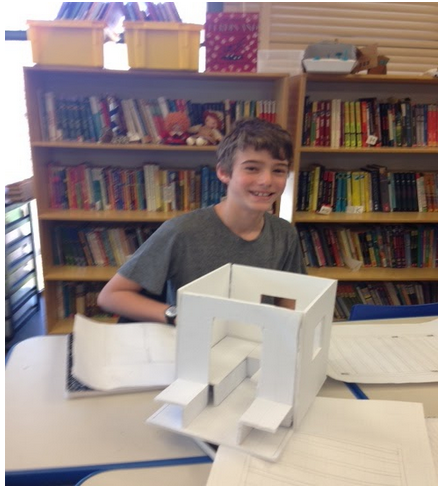March
14
Four Reasons I Use Twitter in My Classroom
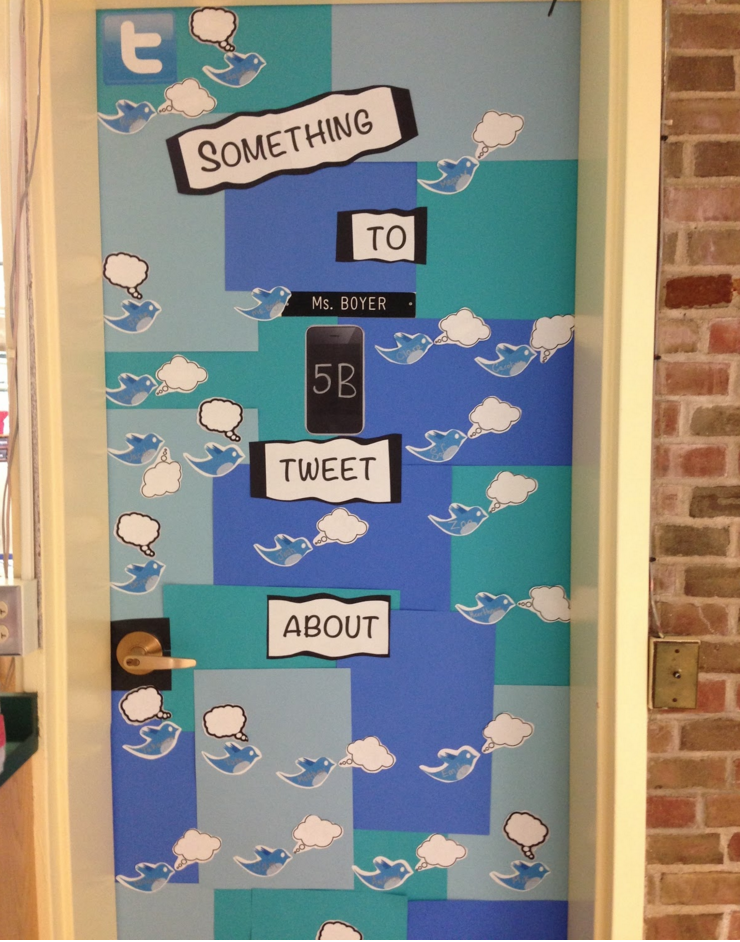
Using Twitter in my classroom has certainly elevated my tech savvy status with parents as well as my instagramming 5th graders who have never known a world without digital devices. We live in a very social world, so why not use social media in the classroom? Social media is a part of daily life for millions of people on our planet and it’s not going away any time soon. Using it in my classroom allows me to model appropriate use and teaches my students necessary skills they will need for their lives beyond our classroom.
While there may be many extraneous reasons to use social media in my classroom (it makes my life easier because it’s organized as well as time and space efficient), it really comes down to four main reasons:
TWITTER CONNECTS ME WITH PARENTS
Using social media in a classroom gives parents a window into their child’s day. The learning becomes transparent as I tweet all content area charts (see below) made in class so they are available to all students at home, to be used as teaching tools/support for their homework and review. Homework assignments are also Tweeted after reviewing them in the classroom. We all benefit when there is ample time to discuss the assignments and less time spent copying the assignment.
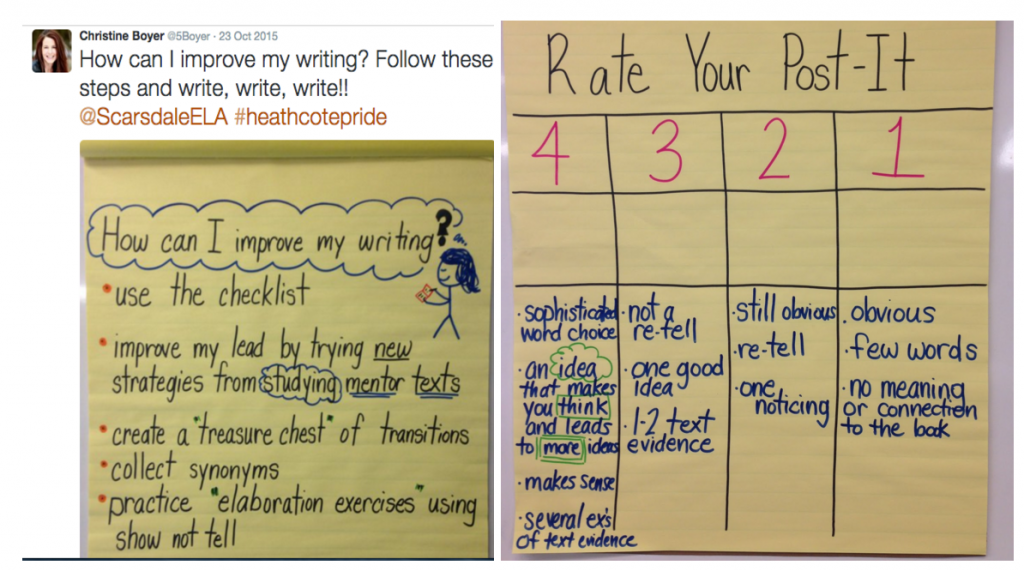
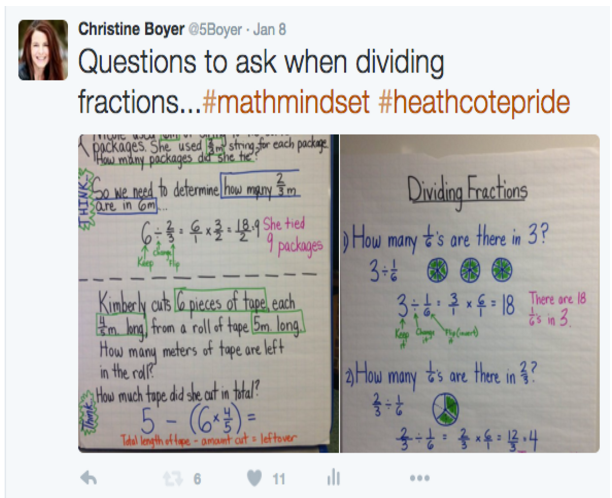

Tweeting charts lets the parents know what their children are doing in school and in addition, students often use them as reference tool for future assignments and homework as they are archived in our class Twitter account.
TWITTER EXPANDS THE WALLS OF MY CLASSROOM
Our class Twitter handle is @5Boyer and while I start the year orchestrating our tweets, my savvy students quickly start to ask, “Do we have to copy that or will you tweet it?” or “Can you take a picture and tweet it, I want everyone to see what we’ve done?” My students have many questions and it would ultimately be a shame if I was the only voice that answered them. We tweet to others to ask questions, why not go straight to the experts? Once my class Tweeted to the International Space Station asking, “How many sunsets do you see in a day?” AND The ISS Tweeted back! Imagine how exciting that was for 23 fifth graders (not to mention their teacher). Tweeting student work now becomes an instant celebration as it is shared with a much wider audience. As a teacher, I retweet relevant information and LOVE how that sparks a conversation in the classroom. Note in the tweet below, I was at home reaching out to my class as the spacewalk was starting before school hours. I added others to the tweet by inserting their twitter handles, check out their response.
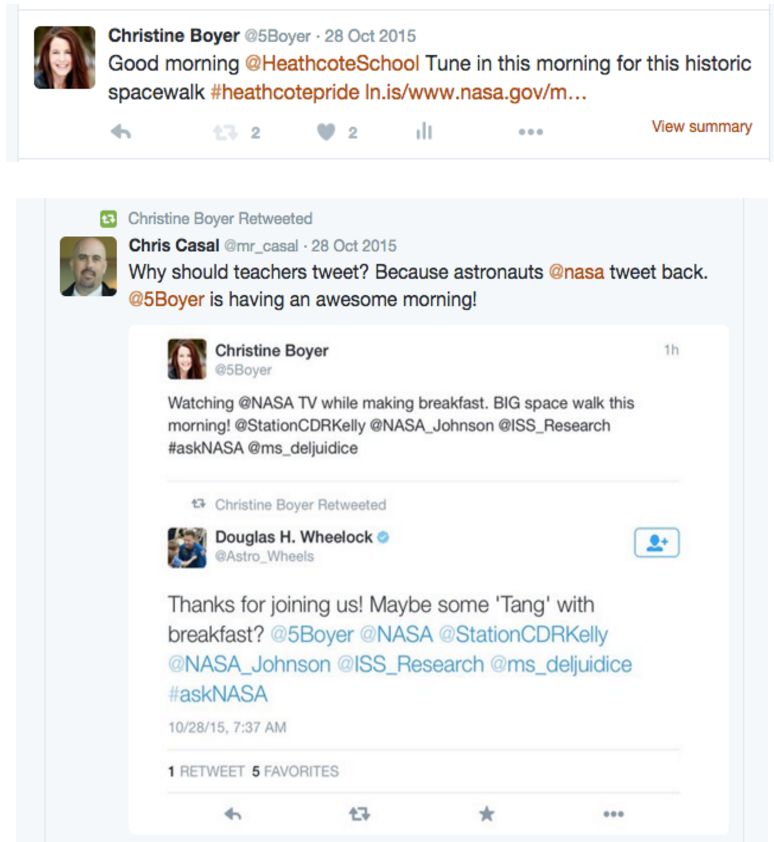
In most of my tweets I add the hashtag #heathcotepride as our amazing tech guru has created a living bulletin board for all school related tweets and to his credit almost all of our staff is tweeting!
TWITTER CONNECTS ME WITH OTHERS
WHO SHARE THE SAME PASSIONS
Professionally, I have built a network of teachers, learners, and experts whom I can learn from every day. There are incredible things happening in the world of education and I have a front row seat with an international view. Only social media can deliver that. I can connect with others who will be attending the same conference, see what’s going on in classrooms around the world or simply be inspired by other amazing teachers. Additionally, Twitter chats make it possible for me to participate in professional conversations in my pajamas. Twitter chats are when a group of twitter users come together at a predetermined time to discuss a certain topic using a specific hashtag with each tweet. Chats serve as a networking opportunity in addition to an awesome learning environment! #edtechchat is one favorite and @iChrisLehman hosts many thought provoking chats focused on reading and writing.
TWITTER HELPS ME CONDUCT RESEARCH
Twitter offers direct access to the experts and the information is current. Many museums are on social media and post highlights on museum exhibits, special events and relevant articles. Scientists, journalists, athletes, engineers, bankers…millions of professionals are on social media. When my students are given a choice within their research projects, they often choose topics/people that are trendy and not easily researchable in books, (and if there is a book, it’s not in language a fifth grader can easily understand). Recent research topics have included: How Has Social Media Impacted Our Daily Lives? What are Football Combines?, When Will Time Travel Be Possible? and Astronaut Scott Kelly and Life in Space. Students learn how to use social media as a primary source when making connections with the experts in the field that they are studying. Available literature may not be accessible, but people rarely deny a student the opportunity to conduct an interview once the initial contact has been made.
In the process of writing this post I became curious as to what my students might say so I asked them, “What do you all think of social media in the classroom?”, here’s what they said;
- “My grandma lives in Florida and Twitter helps her see what I’m doing in school, she likes that”
- “Twitter can help others learn from what we’re doing”
- “It saves on paper – we have all the charts without making 24 copies of it”
- “It helps us to document our work”
- “Tweets of pictures, charts and homework help us to review our work from home easily”
- “We can share work with our parents”
- “It takes too long to get to School Wires, Twitter is really fast and easy”
- “If I’m sick or on vacation early, I can keep up on the work on Twitter”
- “Twitter is a good thing – when my mom asks what I did in school, I usually say I don’t know, but now we can check on Twitter”
- “Twitter is a good way to communicate with people who we can’t interact with directly. Like astronaut Scott Kelly who tweeted to us”
- “I use Twitter to see what’s going on in school. I use Instagram to follow friends who have moved and see what’s going on.”
- “Vine and Twitter are good for following my interests, like a sports team, a car company. I can see how they’re doing.”
Time is precious and twitter lets me complete a multitude of tasks in a short amount of time. It’s a tool that I have come to depend on for communicating daily with parents, colleagues, and astronauts. Wall Street and CNN have their tickers that deliver up-to-the-minute relevant information – that is what twitter has become for me and my students.
Originally published February 1, 2016 Daily Genius
